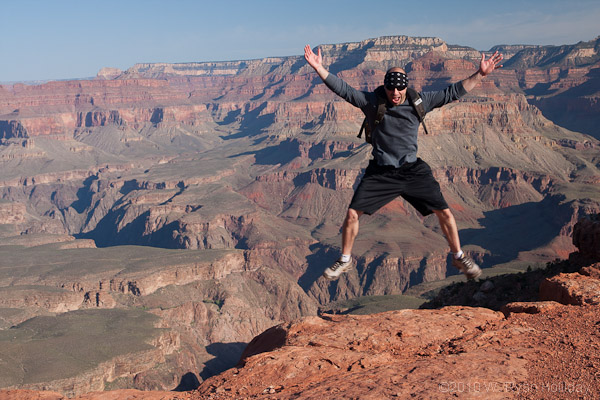Since it’s the end of the month and I’m one entry short of the three entry goal, here are two more pictures taken during last year’s World Tour, this time from Tanzania.


"My life amounts to no more than one drop in a limitless ocean. Yet what is any ocean, but a multitude of drops?" — David Mitchell
Since it’s the end of the month and I’m one entry short of the three entry goal, here are two more pictures taken during last year’s World Tour, this time from Tanzania.


Back in February I wrote the following:
What gives me hope is that while the population at large often despairs over such issues, anytime I sit down with a group of engineers the conversation is inevitably about understanding the problem and figuring out what solutions are viable. If society can’t be convinced to take action on an issue through the government, engineers search for other options.
I read a lot of news that continues to make me hopeful about the steady technological progress being made, and while it may be of interest mostly just to me, here’s one such example. First, a caveat: most new companies and technologies will fail for one reason or another – they will be poorly managed, there will be some unforeseen problem that throws the business model into disarray, or they will simply be unlucky. This journal entry isn’t necessarily meant to highlight something that will definitely become a solution to the world’s problems, but is simply meant to illustrate one way that solutions are being developed to address seemingly dire issues, and how those solutions have the potential to make the world a much better place.
Tesla is in the process of building a massive lithium-ion battery plant that will double the world’s supply of lithium-ion batteries when it is running at full capacity. Business analysts are focusing on the fact that this factory will eat up a huge supply of the world’s lithium, driving up prices and potentially depleting the world’s reserves of this valuable element. These analysts suggest that the world simply won’t have what it needs, resulting in manufacturing shortages and disruption to the technology sector. Engineers, however, mostly ignore the business analysts in this case. So why the difference?
Concentrated lithium reserves are rare, but as a trace element lithium is the 25th most common element on earth – there are 230 billion tons of it in seawater alone. Current methods of extracting lithium involve processing it from salts and brine pools, which requires evaporation followed by disposal of potentially toxic byproducts. Queue the engineers. While the following may not end up being the solution to the world’s lithium needs, it provides an example of how engineering seems to always find solutions that defy the doom-and-gloom scenarios of business analysts.
Today, the three main problems with lithium production are:
Enter lithium extracted from geothermal wastewater. Geothermal plants drill into the earth’s crust to tap into superheated water which is brought to the surface, used to generate power, and then pumped back into the formation from which it was extracted. This geothermal water just so happens to be very high in mineral content, including valuable elements like lithium. Suddenly, the problems associated with lithium production are not so severe:
Making this method of lithium production an even bigger win, using geothermal wastewater for production of rare elements helps reduce the costs of geothermal power in two ways. First, a major issue faced by geothermal plants is the buildup of mineral deposits in the pipes used to return wastewater to the geothermal reservoirs, so extraction of some of those minerals reduces the wear and tear on the infrastructure, meaning pipes have to be replaced less often. Second, companies using the wastewater compensate the geothermal plant for providing the water, introducing an additional revenue stream for the plant. Thus, in the end the world gets both a cheaper, cleaner source of rare elements, and reduced costs for a renewable energy source.
In this particular example, the first attempt to extract lithium from geothermal wastewater has had a rocky rollout, with the first company to build a demonstration plant now facing funding difficulties, but a solution will be found. Where the majority of people see problems, the engineers of the world see potential solutions, and that gives me confidence that the worst of the world’s issues will eventually be solved; I’m excited to see what innovations will be created in the process.
April has been an uneventful month, but here’s the latest:
Since May 1 will mark the start of a work-free period of undetermined length, and thus the first chance since the world tour to go exploring, hopefully next month will offer far more interesting subject material for future journal entries.
Sometimes, when it’s 11PM on the last day of the month and you’re one short of the three-entries-per month goal, you just post a bunch of old pictures of the person most related to you:

In a continuing campaign to highlight good news in the world, here are a few more reasons to be optimistic:
Here’s the summary of life’s events over the past month:
Confirmation bias is a well-studied aspect of human behavior that shows that people will interpret or cherry pick information in a way that confirms their own beliefs. In practice this means that in some cases, people who are more educated about a subject tend to be more adamant that an incorrect position is correct than those who are less educated on the same subject. This fact helps explain why no amount of additional info will convince someone who believes that vaccinations are harmful that their opinion is deeply flawed, or convince a global warming skeptic that 97% of climate scientists really do know what they are talking about, or convince someone who thinks that GMOs are inherently dangerous that 88% of scientists really do know what they are talking about.
A recent Facebook posting from National Geographic that referenced global warming as a likely cause of craters in Siberia provides an example of this bias. Assuming that National Geographic attracts a fairly educated audience, most of the comments still deny that current climate change is a problem created by man:
Given the reality that people cannot be convinced by providing them with more information, a lot of the world’s problems might seem hopeless – how do you solve a problem that a significant percentage of the population is dangerously misinformed about when more information will only reinforce their existing belief? What gives me hope is that while the population at large often despairs over such issues, anytime I sit down with a group of engineers the conversation is inevitably about understanding the problem and figuring out what solutions are viable. If society can’t be convinced to take action on an issue through the government, engineers search for other options. We already have the examples of Tesla Motors changing the paradigm on electric cars from “greenest vehicle” to “most desirable automobile”, and Solar City changing the paradigm on solar panels from “greenest solution” to “most economical solution”, and I’m optimistic that this trend will continue. It is probably too late to undo much of the inevitable environmental disruption that will ensue from climate change – sea levels will rise, animal populations will be displaced or disappear, and weather will become more severe – but in the end I honestly believe that the problem will be solved in spite of the fact that denial of the issue, reinforced by confirmation bias, makes the eventual solution far more difficult to reach.
Exactly six months ago I was just over halfway through the world tour and spending my third day in Kruger National Park, and that is as good of an excuse as any to post some pictures from the trip that didn’t previously make it into the journal.





One of the tricks to life is coming up with mental constructs to deal with difficult situations. Religion fills this role for a lot of people – when bad things happen the way to cope is by saying that it is God’s will, or a test of faith, or some other divine intervention. For me, using religion as an explanation for tragedy is tough since I’m unconvinced by the idea of the Creator spending His valuable time devising unfair and often petty difficulties for each and every creature in the universe, so other coping mechanisms are in order.
One of those coping mechanisms came out of a discussion with my brother ages ago. In one of our many, many unusual discussions that have occurred over the years Aaron started talking to me about Unfortunate Aaron – his twin out there somewhere in the universe, or maybe in a parallel dimension, who had the exact opposite fortunes. Aaron’s life was good, which meant Unfortunate Aaron’s life was bad. If Aaron got sick, Unfortunate Aaron finally got to enjoy a healthy day. If Aaron ducked a punch in a bar fight, Unfortunate Aaron got decked. It’s obviously a ludicrous proposition, but the idea of Unfortunate Aaron, and later Unfortunate Ryan, helped highlight how good things were for us, and gave us something stupid to smile about when things were bad. The most pointed example came on a fishing trip where Aaron got horrifically seasick. He must have thrown up a few dozen times, and at one point when I went inside the boat to find him curled up in the fetal position, his surprisingly upbeat attitude was that “Unfortunate Aaron is so happy not to be barfing for once!”
I’ll be the first to admit that the idea of a bizarro twin with the exact opposite fortunes of myself is a ridiculous concept with absolutely no basis in reality, but it’s an idea that still makes me feel better during bad times. I have a great life, and when things do get rough the thought of Unfortunate Ryan’s fortunes improving slightly highlights how good I have it most of the time. This idea of a shadow Ryan in a parallel universe is no more valid than that of an old guy in a toga who wants to micro-manage every hardship I might face, but it’s one that seems to allow me to put the inevitable bad times into perspective in a way that a bearded man on a cloud dishing out misery does not.
Shockingly, Audrey and I have been homeowners for almost exactly three years now. Mostly because it’s interesting to me to go over the changes we’ve made to the house, here’s a list of the biggies, past, present and future:
Homeownership clearly has its challenges – every time the contractors told us the price for the above items the involuntary response was inevitably “DOH!” – but unlike when we were renting, the expenditures kind of feel like putting money in the bank, with the added bonus that we get to live in a house without leaks or creepy bugs.

Based on my past track record the following predictions are statistically highly unlikely to come true – if you are looking for more accurate predictions, buy a magic eight ball or make use of a small herd of puppies. That said, I actually spent more time than normal trying to come up with well thought-out predictions for 2015, but history suggests that re-reading this list in twelve months will be an embarrassing endeavor:
There they are. You can let the mockery begin now, or you can wait until January 2016 to mock in hindsight. For the truly bold, the comments link is there for you to make your own predictions and show me how it should be done.
First, to put the embarrassment that are my 2014 predictions into their proper context, here is the record of futility from past years:
I can at least say that this year’s picks were only my second-worst showing of all time…
Not even close. Democrats lost nine seats. It was a horrible map for the blue team with many races in conservative states, and they will almost certainly regain several seats in 2016, but I was way off.
Again, not even close. Republicans gained thirteen seats for a total of 247. My understanding of the electorate clearly demonstrates why I will never be a politician.
Facebook closed the year at $78.02 and Twitter closed at $35.86. The number of people who seem to think “Farmville” is the key to gigantic revenues continues to confuse me. Zero-for-three with the predictions so far.
Ouch. In 2014 he won… nothing. Nada. Only one top-25 finish all year. Granted, his back was messed up, but I still don’t see how the guy who was the Michael Jordan of golf suddenly looked more like the Michael Jordan of baseball. He’ll come back, but in the meantime I’m still not on the scoreboard.
HE’S ON THE BOARD. I continue to believe that it’s simply impossible – logistically and from an economic standpoint – to kick eleven million people out of the country and then deal with the repercussions that come from losing a significant portion of the country’s low-income workers. Thus it seems like Republicans should just pass something to get this issue out of the way, deal with the fallout, and stop it from continuing to hurt them with the nation’s fastest growing minority. Despite my clearly omniscient advice, the House never put the Senate’s immigration bill up for a vote during the entire 113th Congress, so immigration will again be a major reason for Latinos to vote Democrat in 2016.
I was probably two years too early on that one. It’s coming – Google and Apple are the only ones who could pull it off, and both of them will do something eventually.
BEST WRONG PREDICTION EVER. Granted, the Cavs still aren’t winning very much, but at least now they win occasionally, the games are entertaining enough to be televised, and Aaron and I again have reason to break out the Anderson Varejao wigs.
The most recent data available had Apple dropping to 22.8% in the third quarter of 2014, but that percentage was expected to jump slightly in the fourth quarter due to the new iPads being released, thus missing my 20% target. I continue to be bad at understanding technology.
The Model X is now scheduled for release in early 2016 – Tesla makes unbelievable automobiles, but is horrible at estimating release dates. They opened their first battery swap station in December, and I was very, very wrong about them putting off building a battery factory – they have staked their future on the Gigafactory, which is now being built outside of Reno. I am usually better at the Tesla predictions, and the scorecard falls to an impossibly low one-for-nine.
4K televisions were all over Best Buy this past Christmas, but content is still next-to-impossible to find, with only Netflix making much content available in 4K. More out of self-pity than anything else I’m giving myself half credit here, bumping the tally up to a pitiful 1.5 correct.
They traded the #4 overall pick, then picked Justin Gilbert, a cornerback, with the #8 pick, and also took Johnny Manziel with the #22 pick. I’ve never been a fan of Johnny Football, and am even less of one after seeing what he did this past season, but despite their picks not panning out, at the time it seemed like a far better draft than I was expecting. Hopefully the extra first-round pick this year turns into someone who is best known for his prowess on the field, and not for photos of him drinking in a pool while riding on an inflatable swan.
Didn’t happen, although Jack-in-the-Box didn’t seem to care and launched an entire “Munchie Meal” campaign aimed at potheads.
This one will happen, but it didn’t happen in 2014 to the extent that I expected. We should have motion detectors tied to smart lights that are tied to smart water heaters that work with smart thermostats that sync up with smart sprinklers, all updated from the internet and controlled from cell phones. I mean, it’s 2015 – Marty McFly is supposed to be getting chased by Griff on a hoverboard by now!
There it is: 1.5 out of 13 (12%). Had I made one more pick I might have tied 2013’s record of futility. Getting the Lebron pick wrong at least softens the blow – even if the Cavs aren’t winning, basketball is more fun when the NBA’s best player is on your favorite team. Now onwards to 2015, when the picks have to go better, don’t they?
Mostly because it’s fun for me to put these lists together, for the final post of 2014 here’s a look back at some news events that I got excited about:
I’m sure I’ve probably missed some obvious stuff (Europe landed a probe on a comet!), but that’s a decent sample of things that excited me during the year. Hopefully 2015 will continue the trend – we live in exciting times.
Here’s an attempted wrap-up of the events that have occurred in the two months since knee surgery:
And now, after four entries spread out over a full month, the journal is again current and ready to ring in 2015. More than twelve years since the first entry, what was originally just a way to avoid writing emails has turned into a record of nearly one-third of my life, and I’m grateful to the twos of readers who continue to check in regularly to share it.
It took me long enough to get to “Part 3” of the “Catching Up” series that there will likely need to be a “Part 4”, and possibly even a “Part 5”, in order to get back up-to-date. Timely journal entries are apparently not my thing. The last entry covered Scare the Children 2014, and this one gets us through the beginning of November when I went into the hospital for my first-ever surgery.
First, some history: back in 2011 I was running a lot and getting back into good shape, then in August of that year I felt a crunch in my knee while on the treadmill and wasn’t able to run again without my knee swelling up to impressive size. I went in to Kaiser, my insurance provider at the time, and told them I had probably torn something in my knee. I gave them my running history, let them know that I had experienced several minor injuries over the years and knew the difference between soreness and something more serious, and then waited to see if an X-ray would be sufficient of if they would need to schedule an MRI. Apparently neither was in the cards: despite my protestations that something was very wrong I was sent home with instructions to ice the knee and take aspirin. Combined with previous bad experiences, that was the last time I ever went to Kaiser.
Unfortunately, as a self-employed person, I was in a position where I could not switch insurance providers without facing the dreaded “pre-existing condition” denial of coverage. While Obamacare is obviously hated by some, the law’s ban on using pre-existing conditions as a reason to deny coverage was a godsend for me, so I waited until it went into full effect on January 1, 2014, and after fighting with the Covered California website and with the overwhelmed Anthem Blue Cross, I finally switched to insurance that allowed me to see a sports medicine doctor. I visited UCLA, was quickly scheduled for an MRI, and was diagnosed with a torn meniscus. Apparently the normal protocol is to try to resolve such things via physical therapy, but despite a few months of twice-weekly visits and lots of exercises I was never able to run more than two miles without having knee pain the following day.
By the time it was clear that physical therapy wasn’t going to resolve things it was too close to the 2014 World Tour to schedule surgery, but shortly after returning home from Africa I met with one of the best knee surgeons on the West Coast and made an appointment to get sliced up. At 6:30AM on November 4 Audrey took me into the hospital, and an hour later an anesthesiologist told me “c’mon, take a deeper breath than that”. An hour after that my eyes opened, and then they wheeled me out of the hospital. Two days later I was walking, and as of last week I’ve been given clearance to try running again on a limited basis. Christmas day Aaron and I went for a short run around the neighborhood, and so far the knee has remained its normal size. Since pounding concrete sidewalks hurt my knees even before the meniscus tear I’m waiting for our treadmill to be repaired before trying to run again, but for the first time in over three years I’m cautiously optimistic that I may yet be able to resume the only sport I was ever good at.